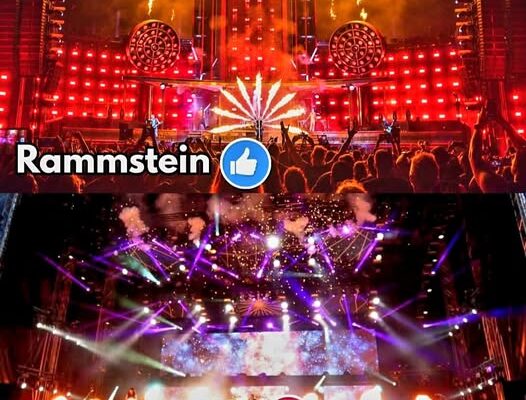“Fire Meets Fantasy: Rammstein and Nightwish Prove Why Europe Still Rules Symphonic and Industrial Metal”
“Fire Meets Fantasy: Rammstein and Nightwish Prove Why Europe Still Rules Symphonic and Industrial Metal” is more than a headline; it is a declaration of how two of Europe’s most powerful musical forces continue to dominate global stages by merging art, spectacle, and sonic innovation. Rammstein, the German juggernaut of industrial metal, and Nightwish, the Finnish titans of symphonic metal, might appear as two very different entities on the surface, but together they showcase the diversity and depth of European metal in ways no other region has managed to replicate. Both bands have been carrying the torch for decades, not only shaping their respective genres but also pushing the boundaries of what live music can be. To understand why Europe still rules these spaces, one must look at the essence of these bands: the fire of Rammstein’s industrial precision and the fantasy of Nightwish’s orchestral imagination.
Rammstein has never been a band content with blending into the background. Their very existence is an act of defiance against conformity, with songs that pierce through political, social, and cultural topics, often cloaked in provocation and theatrics. Their industrial metal is sharp, heavy, and mechanical, a sound born from Germany’s post-industrial landscapes, but elevated to theatrical extremes through pyrotechnics, bold lyrics, and a stage presence that borders on performance art. When Rammstein performs, the stage becomes a battlefield of fire, smoke, and sound, where every flame and explosion is choreographed with the precision of a ballet. Yet beneath the spectacle lies a deep understanding of industrial metal’s essence: relentless rhythm, pounding riffs, and an atmosphere that grips audiences like a machine in motion. Rammstein embodies the “fire” part of this headline, representing Europe’s unyielding ability to create music that is as confrontational as it is captivating.
Nightwish, on the other hand, represents the “fantasy.” Founded in Finland, Nightwish carved out a space in the late 1990s and early 2000s that few bands dared to enter: the realm where heavy metal collides with full orchestration, operatic vocals, and grandiose storytelling. Their music is like stepping into another world, one filled with myths, dreams, and emotions that transcend language and culture. With a rotating lineup of powerful vocalists, from Tarja Turunen’s operatic might to Floor Jansen’s commanding range, Nightwish has always understood the magic of blending human voice with symphonic arrangements. Their live shows are less about fire and destruction and more about weaving a tapestry of sound that feels cinematic, almost like the score to an epic fantasy film. Where Rammstein channels the mechanical and visceral, Nightwish channels the spiritual and fantastical, reminding audiences that metal can be as beautiful and moving as it is heavy and dark.
When these two forces are placed side by side, they reveal why Europe remains the epicenter of both industrial and symphonic metal. European bands tend to lean toward a deep sense of artistry, valuing both musical craftsmanship and live performance as equally essential parts of the experience. Unlike the often straightforward, riff-driven approach of American metal, European acts like Rammstein and Nightwish integrate layers of theater, literature, philosophy, and art into their work. This creates music that doesn’t just sound heavy but feels immersive, pulling audiences into a complete world. Rammstein achieves this through satire, provocation, and fire, while Nightwish does it through myth, melody, and grandeur. Together, they show two sides of the same coin: metal as both a weapon and a dream.
The global success of both bands also proves the enduring power of European innovation in metal. Rammstein sells out stadiums worldwide, their concerts often resembling apocalyptic festivals of flame that leave audiences stunned. Their German lyrics, far from being a barrier, have become part of their mystique, with fans from across the world chanting along to songs they may not fully understand, but deeply feel. Nightwish, similarly, has brought symphonic metal to audiences far beyond Europe, headlining festivals and touring globally with orchestras, choirs, and complex arrangements that defy mainstream trends. Their ability to remain authentic while still reaching international audiences is a testament to Europe’s unique ability to export culture without diluting its essence.
What unites both Rammstein and Nightwish is not just their European heritage but their commitment to the idea that metal should be more than music—it should be an experience. Rammstein’s shows are unforgettable partly because of the scale of their pyrotechnics, but also because they dare to explore taboos and challenge norms. Nightwish’s shows are unforgettable because they transport audiences into a realm where the boundaries between classical music and heavy metal dissolve, creating something entirely new. In an era where many bands chase trends, these two have become trendsetters by staying true to their visions, and their reward is a level of global respect and admiration few can match.
The endurance of these bands is also remarkable. Rammstein has been active for more than three decades, surviving controversies, political criticism, and changing musical landscapes, only to emerge stronger with each album and tour. Nightwish has endured lineup changes, personal conflicts, and even shifts in the music industry, yet their core vision remains intact, if not stronger than ever. Both bands exemplify the European ethos of resilience and reinvention, proving that longevity in metal is achieved not by playing it safe but by daring to take risks.
Perhaps most importantly, Rammstein and Nightwish highlight how European metal thrives on contrasts. Fire and fantasy, industry and imagination, provocation and poetry—these dualities give the music its depth and its staying power. Fans of both bands often cross over, appreciating the raw spectacle of one and the refined beauty of the other, because at their core, both deliver something universal: emotion amplified through sound. Whether it is the adrenaline rush of Rammstein’s flames or the goosebumps from a soaring Nightwish chorus, the result is the same: audiences leave transformed.
The global dominance of these bands also signals a larger truth about European metal: it remains rooted in its cultural context while speaking to universal human experiences. Rammstein draws from German history, culture, and language, while Nightwish taps into Finnish myth, European classical traditions, and a universal longing for beauty and transcendence. In doing so, they remind the world that authenticity resonates louder than trends. It is not about imitating others but about owning one’s identity and amplifying it to the world. That lesson is what keeps Europe ahead in the realms of symphonic and industrial metal.
In the end, “Fire Meets Fantasy” is not just a metaphor but a living reality embodied by Rammstein and Nightwish. One brings the fire that burns through conformity, while the other brings the fantasy that elevates imagination, and together they prove that Europe is still the heartbeat of symphonic and industrial metal. In a world where music is often reduced to digital streams and fleeting trends, these bands remind us of the power of live performance, of spectacle, of risk-taking, and of the profound ability of metal to touch the human soul in countless ways. Europe still rules not because it clings to the past, but because it dares to imagine the future, and with Rammstein and Nightwish at the forefront, that future remains as fiery and fantastical as ever.



